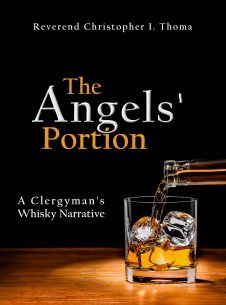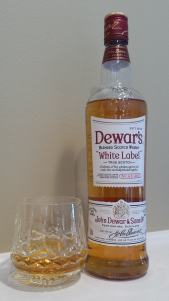Christopher Ian Thoma's Blog, page 46
November 6, 2015
Smokehead, (No Age Stated), 43%
 Bedtime was swiftly approaching. I’d urged with a usual sternness that the children get moving and gather up all their things and put them in their proper places.
Bedtime was swiftly approaching. I’d urged with a usual sternness that the children get moving and gather up all their things and put them in their proper places.
Evelyn, my six-year-old, began stretching and reaching out into multiple directions, grasping at nothing as though it were something, pulling and gathering things close that none of us could see.
Intrigued, I asked, “What are you doing, Evelyn?”
“My tummy doesn’t feel so good. I’m gathering up all my farts to take then with me.”
Only a few paces away, waving her hand and chiding with disgust, Madeline added, “You missed some over here, that’s for sure.”
“Would you get them for me, Maddy?” Evelyn asked with a curious solemnity. “My arms are full,” she pressed and then skipped off to her bedroom.
I didn’t say a word. I was stunned. I was frozen in the moment, only watching and listening with incredulity as Madeline replied with equal seriousness, “Sure.” And then just as Evelyn, she reached into the nothingness to collect her sister’s invisible things for storing away in their proper places.
You’ve got to be kidding me. And then I smelled that Maddy had missed some, too. Covering my mouth and nose, I muffled a yell for both girls to put the others away and come back for the rest before they got away.
This reminded me of the response I sometimes get from my wife when I open up one of my smokier whiskies. She can tell where it’s been because it leaves a footprint of sorts, a gatherable aura wherever it has been carried. She doesn’t like this at all, and it isn’t beyond her to mandate that I take the whisky to another room and then “come back and get its stench.” After watching my daughters, I think that it may be possible to fulfill my wife’s directive. I’ll just need to ask the girls how to do it properly.
This was the scene when I opened the Smokehead. I opened the gate and almost immediately came the gliding of smoke and freshly cut grass. I liked it, but I think Jennifer was offended. That’s a good thing. It means that this finely laced smoke maiden would be all mine.
But the nosing isn’t everything.
Having retreated to another chamber, I sipped and savored with glee. There’s no age statement on this particular edition, but it’s toddlerhood is more than evident in the initial harshness that meets you in the first mouthful. I’ll admit, though, that the palate continued the outdoorsy sensations, except this time an earthy summer humidity was added to the freshly cut grass. The weight fastened itself to my tongue and compelled me to consider starting an autumn bonfire in the backyard. Too bad it was almost 10:30 p.m. and the morrow was beckoning.
“Not what I expected,” I thought.
The medium finish brought along an agreeability that was on its way to stellar – on its way, but not yet arrived. Nevertheless, I was drawn to pour another dram almost immediately in order to give it a chance to get there. And so I did. But sadly, it did not. It remained an adolescent still hoping to mature to fuller individualities.
In all, for its suspected youth, the Smokehead isn’t all that bad. I’m sure that once the distillers figure out what else is needed, it will get better. But I suppose the bigger dilemma is figuring out where exactly my daughter’s bedroom they are storing Evelyn’s farts. Knowing the sensitivity of both of these tender damsels, it is most probable that they are opening their bedroom window and setting them free.
Having been there to smell the ruinous vapors, for that I am thankful.


November 5, 2015
Review – Glenfiddich, 12 Years Old, 40%
 “Let there be God, let there be Sunday morning, let there be smiling Episcopalian ministers in shining white surplices…but let there not be these dark and draggling horrors on the nightside of the universe.”
“Let there be God, let there be Sunday morning, let there be smiling Episcopalian ministers in shining white surplices…but let there not be these dark and draggling horrors on the nightside of the universe.”
These are the thoughts of Louis Creed, the protagonist in Stephen King’s novel Pet Sematary, as he carries the body of his dead son, Gage, through a densely forbidding forest in the middle of the night. His goal – to rebury the boy’s tiny frame in a forbidden burial ground so that he will live again. Along the way, he hears a sound. He suspects it to be the Wendigo, a large and lumbering creature of Native American legend described as turning men to cannibalism with a mere touch.
 Even though the context suggests the main character’s fearfulness at the sound of this massive creature passing through the darkness, knocking down trees and coming within yards of discovering him, I wonder if Mr. King was actually doing what many authors do, that is secretively communicating a life experience. My guess is that King, sitting at his typewriter, just took a sip of the Glenfiddich 12-year-old.
Even though the context suggests the main character’s fearfulness at the sound of this massive creature passing through the darkness, knocking down trees and coming within yards of discovering him, I wonder if Mr. King was actually doing what many authors do, that is secretively communicating a life experience. My guess is that King, sitting at his typewriter, just took a sip of the Glenfiddich 12-year-old.
I wonder.
As one of the best-selling single malt Scotch whiskies on the planet, this large and lumbering edition has the ability to turn its consumers into whisky cannibals – or so I’ve heard it said.
Okay, maybe not like people who eat human flesh. Maybe more like people who prefer things like raw meat and prefer to lick the blood from the plate afterward because they like salty, sour things.
Honestly, I don’t know why this whisky is so popular. The nose is barely sweet, giving over a very subtle floriated perfume, and the palate is dry, dreadfully sour, and difficult to swallow – like you just bit the heads off of the flowers you were smelling in the nosing. I’m almost concerned that this whisky is nearly as bad as Scoresby, except for some reason, in comparison (and I can’t believe I’m about to say this) Scoresby should be commended. While Glenfiddich lives a deceitful marketing life, working diligently and successfully to fool the masses into thinking that their 12-year-old edition is worth $30, Scoresby so honestly accepts its stature as a $10 bottle of sewage. It’s nice to know that at least one of the bottom shelf catch-basin cat-gut whiskies has this kind of integrity.
And before I get distracted by other more colorful terms that come to mind after a sip of the Glenfiddich 12-year-old, I must describe the finish.
Salty, like blood. Also sour. Vinegary. Ungood. Is “ungood” a word? Well, it is now, thanks to Glenfiddich.
No matter.
On second thought, it does matter. When you finally finish the bottle off, when it is dead and gone, whatever you do, don’t go up and past the Pet Sematary into the ancient burial ground looking to bury it in the ground that it might be reborn.
Some things need to stay dead. One of those things is the Glenfiddich 12-year-old edition.


November 4, 2015
Review – Highland Park, 18 Years Old, 43%
 My middle name is Ian. My parents were huge Jethro Tull fans.
My middle name is Ian. My parents were huge Jethro Tull fans.
Even though I have a nomenclated connection to the lead singer and world-renowned rock flutist, I wouldn’t say that Jethro Tull is necessarily one of my favorite bands, although, when it comes to lyrical prowess, Ian Anderson is quite nimble. I listen if only to be schooled in vernacular dexterity.
For example, combined with its minstrel-like undercarriage, “Poppies red and roses filled with summer rain…” just seems to spin from “Songs from the Wood” like a medieval quadrille. Alliterative. Syncopated. Very crisp.
 Coming home from a School Board meeting a few nights ago, I decided it had been a while since I’d listened to my namesake, so I scrolled through and pulled up a “Best Of” compilation, and for the twenty minutes of “motorway stretching right out to the sun,” I settled into the likes of “Songs from the Wood,” “Skating Away,” an abbreviated version of “Thick as a Brick” (which was quite popular in the early part of the year I was born), a live version of “One White Duck,” and of course, “Aqualung.”
Coming home from a School Board meeting a few nights ago, I decided it had been a while since I’d listened to my namesake, so I scrolled through and pulled up a “Best Of” compilation, and for the twenty minutes of “motorway stretching right out to the sun,” I settled into the likes of “Songs from the Wood,” “Skating Away,” an abbreviated version of “Thick as a Brick” (which was quite popular in the early part of the year I was born), a live version of “One White Duck,” and of course, “Aqualung.”
I guess that having been rejoined to such odes directly connected to my birth, when I arrived home, I was in the mood to sip the whisky my wife had purchased most recently for my birthday – the Highland Park 18 Years Old.
This is a whisky that requires dim lighting, a comfortable chair near a flickering fireplace, a little light music, and the company of your beloved. It encourages whimsical discussion regarding the events of the day, a compliment, a blush, and a reaching to hold your beloved’s hand.
In the nose there is at first the sense of a cool breeze sweeping through a berry patch and carrying a dissipating peat smoke from a fire burning in the farmhouse nearby. This is all far too enticing to the passerby, and so he investigates the first sip before a more detailed determining can occur.
The palate is equally alluring. The peat holds, but as in the nose, it continues to dissipate, except now it does so amidst hints of hot chocolate and almonds.
There is a medium finish to the experience. The berries prove themselves to be raspberries. The chocolate and almonds give way to a peat smoke doing what it can to become more prominent – not necessarily a resurgence, just more pronounced by the whisky’s oily coating.
Highland Park has an exceptional whisky here. However, like Jethro Tull, it isn’t necessarily something I go to often. Although once acquainted, you’ll notice when it has been absent from your life for a little while. This will drive you to its doorstep for an evening visit and it will indeed be a splendid re-acquainting.


November 1, 2015
Review – Cardhu, 12 Years Old, 40%
 It’s been at least five or six years since it happened last, and back then it only happened because certain members of the congregation were on edge and ready to leave anyway. But it happened today in our second service.
It’s been at least five or six years since it happened last, and back then it only happened because certain members of the congregation were on edge and ready to leave anyway. But it happened today in our second service.
Someone got up and walked out offended by my sermon.
I’ll admit, it was a hard hitting homiletic today. I took the opportunity of All Saints’ Day to be somewhat truthfully appalling in an Orwellian sort of way. In other words, just as Orwell said, “In a time of deceit telling the truth is a revolutionary act,” so also did I work to tear through the listeners’ expectations in a way that would reveal to them that they aren’t free, at least not in the ways that they would believe. I did this by listing every reasonably atrocious behavior I could until I was comfortable that everyone in the room had found themselves securely within the fellowship of human monster-hood.
A pastor knows if this has occurred while greeting the listeners following the service. Indeed, many came through the line today informing me that they’d felt the brunt with personal precision, and the grace was doubly munificent. Good.
But again, about half way through my list in the second service, which was really only a paragraph of my sermon manuscript (although it probably felt much longer because I worked through it very slowly), someone got up and walked out. She was visibly bothered, and she pulled what appeared to be a reluctant husband in tow. Neither came back. The truth regarding mankind’s condition was too much to bear, let alone hear described in a way that meets an individual so exactly, so directly. I only wish she, they, would have waited through the relatively painful measure to the very next paragraph. There they would have heard a better truth; a refreshing solution to the lies they left telling themselves.
There is an uplifting gild to this story, though. I went into that second service having already received a gifted Cardhu in a little bag near the foot of my desk. This gift, given before the first service, had established an unshakable tenor to my day. God obviously knew what was coming my way in only a few hours, and so He saw fit to move a friend to be kind to his pastor.
Again, the day’s demeanor was well balanced and I went home more concerned about whether or not I was going to like the gifted Scotch as opposed to being bothered by someone who did not realize that “truth does not change according to our ability to stomach it” (Flannery O’Connor).
I am happy to tell you that I was pleasantly surprised by this relatively affordable edition.
Just after the cork was drawn, straight from the bottle I nosed the unmistakable peck of a dry red wine. In the glass, it was the same. With a drop of water, strawberries emerged.
The palate poured warm chocolate on those strawberries and then dotted them with powdered sugar.
The Cardhu 12-year-old carries you through a medium finish, clawing a little bit on the roof of the mouth, but diverting with some remnant vanilla tones on the tongue. And while this is a strangely unbalanced conclusion, it isn’t enough to dissuade you from another sip.
Now to refine this truth…
It’s a nice dram, and I’ll most certainly enjoy every sip until the bottle is empty, but I think it is better suited to serve as a beginner Scotch for a wine drinker desperate to explore a different beverage expanse. I’m already well over such a line and need no convincing.


October 31, 2015
Review – The Glenmorangie (1981 Bottling), 10 Years Old, 43%
 If you don’t know by now, or if you are relatively new to the Angelsportion universe, my favorite band is AC/DC.
If you don’t know by now, or if you are relatively new to the Angelsportion universe, my favorite band is AC/DC.
Surprised? You expected me to be someone who bops down the motorway listening to contemporary Christian music, eh? You shouldn’t be surprised, and you should hit the mental delete button on that image. Contemporary Christian music is awful. Terribly awful. I mean, so awful that if I ever get stuck in a situation where I am required to listen to it, to cloak my innermost disdain, it takes everything within me not to claw at my troubled ears as though they were filling with tiny haloed termites attempting to eat the contents of my skull. It hurts to listen to the stuff. Even though it labors tirelessly to be just like what you are hearing on the mainstream airwaves, it tends to be a few paces behind, and therefore classified as “lame.”
But in my opinion, even if in its wannabe manifestation it managed to meet the same musical delta, it would continue to crash and burn in the lyrics department, and for two reasons.
The first is that there are only so many times someone can listen to the same syrupy refrain in any song, and for some reason, contemporary Christian artists feel as though they have to write religious mantras rather than prosaic libretti designed to communicate. I mean, if I have to hear the words “praise you” nineteen more times in the first chorus, then you can count on me turning to a different station. I don’t even know how I ended up here in the first place, anyway. You obviously have no talent and are simply counting on equally shallow Christians not to recognize this particular flaw because you are safely hiding behind a repetitive time-consumer that none of them would feel comfortable criticizing. That’s not me. Your song is dreadful. And that leads me to the second reason, which also deals with substance.
How about writing a song that spends more time talking about what God has done for man rather than what man is doing for God? That is the heart off the church’s message, yes? I mean, if you say “I just wanna praise you” one more time, I think God Himself might puke on you. By the way, do you know the kind of songs that never do this? Hymns. Have you noticed that the church still sings these things? Yeah, I know you contemporary Christian music flakes are trying to get rid of them, but there’s a multitude of reasons why that will never happen, one of which is that they have staying power. You, however, will be chasing after various musical appetites for the rest of your shallow life. Just like Stryper. You probably don’t even know who those guys are, do you?
So anyway, I like AC/DC. They’re not singing the purest things, but neither are you, and the important difference is that what you are singing is being sold as “Godly,” but you are deliberately targeting souls with an incorrect perception of God and His relationship to man. In my opinion, that’s much, much worse. In fact, I think you are the reason no one respects the Christian church anymore. You guys make us look like a bunch of folks that will roll over to preference when challenged. You know who never rolled over in the face of challenge? The guys who wrote those hymns we’re still singing. And while I’m thinking about it, you should know that even Saint Paul pointed out in 1 Corinthians 11:17 that when some Christians get together with good intentions to do stuff, God stuff, their efforts sometimes “do more harm than good.” Paul prefaces this with “I have no praise for you.” If you ever want me to listen to your prattling, when singing about the efforts of man, take aim through your lyrical reticule directly at the darkened heart of man and let Paul write your choruses:
“I have no praise for you. No praise for you. No praise for you. No praaaiiissse for youuu!”
And maybe hire Angus Young to play lead guitar. That would probably help, too.
All of this relates to the Glenmorangie 10 Years Old being reviewed in that this particular whisky seems more like a hymn than a contemporary song. It seems to have staying power.
I received this whisky from a friend who also received it as a gift many years ago. He doesn’t drink Scotch, and rather than let it sit in the back of the cabinet any longer, he so kindly passed it along to me. Just inside the canister was a Christmas card which recorded the holiday gifting date as “December 1981.” I popped it open as soon as I got it home.
The nose was somewhat harsh at first, but after a short swirl and a moment to breathe, the signature Glenmorangie sweetness twirled and whirled up and out of the glass. Very nice.
The palate, like the nose, was somewhat harsh at first, but again, after a few moments, the citrus notes emerged, tapping my tongue with a little bit of honey as it headed toward the finish.
There was a lengthy warmth in the conclusion. I definitely tasted the alcohol, which dampened the mood a little. But in the end, the citrus and honey were there calling out, “Hey, over here! Look over here!” The second time around, I added a little bit of water and everything evened out.
I must tip my hat to the Glenmorangie concocters of days past. I’m glad that I got the chance to meet them through this edgy little dram. In fact…
“I just wanna praise you… praise you… praaiise yoouu!”


October 30, 2015
Review – Johnnie Walker, Red Label, 40%
 Bessie Braddock, a Labour Party politician and member of the British Parliament, became frustrated with Prime Minister Churchill who appeared in session slightly unsteady and bearing a slur that was much more pronounced than usual.
Bessie Braddock, a Labour Party politician and member of the British Parliament, became frustrated with Prime Minister Churchill who appeared in session slightly unsteady and bearing a slur that was much more pronounced than usual.
“Winston,” she chided, “You are drunk, and what’s more you are disgustingly drunk.”
And still, Churchill proved his worth to the nation in a moment’s notice. He proved that even while saddled with delayed senses, he was swifter than all the rest. The complexity of his intellect and the exactitude of his vernacular, no matter his condition, proved that he was exactly the kind of leader a nation needs at the helm during the storms; the one the citizens require at the gates when the enemy approaches.
 “Bessie, my dear,” the hindered Churchill offered so casually before the awaiting crowd, “You are ugly, and what’s more, you are disgustingly ugly. But tomorrow I shall be sober and you will still be disgustingly ugly.”
“Bessie, my dear,” the hindered Churchill offered so casually before the awaiting crowd, “You are ugly, and what’s more, you are disgustingly ugly. But tomorrow I shall be sober and you will still be disgustingly ugly.”
Yes, I know that wasn’t nice, but it made you smile a little, didn’t it? Had this happened in recent history, with the new Nazi party on patrol in America – that is, the political correctness brigade – we most likely would have watched this hilarious exchange on C-Span or YouTube one day only to see Churchill forced by his fellows to apologize on Fox News the very next – most likely slurring his words once again. And yet, by way of responding with such a startling retort, Churchill prevented further offenses. From what we know, Ms. Braddock simply gasped and left the room in a huff. That’s really all she could do. I mean, what do you say in response? The only thing left to say would most certainly have had the TV censors hitting the “bleep” button a few hundred times while Braddock threw a tantrum and pretty much anything else within her grasp in the smirking Sir Winston’s general direction.
 To be honest, knowing a little about Braddock’s politics, the only thing that really troubles me about the exchange is the plausibility that Churchill’s slovenly demeanor that day could very well be attributed to Johnnie Walker Blended Scotch Whisky. It is pretty well noted by the biographers that the Red Label was his preferred liquor. It bothers me that Sir Winston preferred this stuff.
To be honest, knowing a little about Braddock’s politics, the only thing that really troubles me about the exchange is the plausibility that Churchill’s slovenly demeanor that day could very well be attributed to Johnnie Walker Blended Scotch Whisky. It is pretty well noted by the biographers that the Red Label was his preferred liquor. It bothers me that Sir Winston preferred this stuff.
It’s not completely bad, but it in no way rises to the levels of most other selections on the shelf. In fact, in my opinion, if you can just get past the nose, you’ll be okay. Better yet, skip the nosing. That’s the key to getting through the experience.
If you decide to disregard my advice, just know in advance that the nose is heavily medicinal. I mean, if you actually get down to the glass and draw in a reasonable gust, you’ll feel like you just inhaled the fumes from a nearby pharmaceutical company’s exhaust vent. It’s definitively unpleasant.
The palate is a little better. Not great, just better. There’s a little bit of something sweet at first, but it turns too quickly on a peat brick for proper identification. If I had to guess, I’d say sassafras, which would also explain the medicinal characteristics. I know that Native Americans used sassafras for treating wounds.
The finish is long, oily, and warm. Too long. Too oily. Too warm.
If only Sir Winston would have lived long enough to see the blends of his day eclipsed by the wonderful variety of single malts, then he would have had a much wider selection. But then again, who knows. All we know is that a great man liked a less-than-great Scotch. We can at least thank Johnnie Walker for its inspirational relevance.


October 29, 2015
A Friend Reviews “The Angels’ Portion: A Clergyman’s Whisky Narrative”
 As a pastor, you learn who needs to be coddled in the parish — that is, who those folks are that if you do anything — ANYTHING — that rubs them the wrong way, you can pretty much expect that they will pick up their marbles and go somewhere else. In post-modern, self-centered America, this is becoming more and more of a danger. Churches have their fair share of these souls. And I guess that’s okay.
As a pastor, you learn who needs to be coddled in the parish — that is, who those folks are that if you do anything — ANYTHING — that rubs them the wrong way, you can pretty much expect that they will pick up their marbles and go somewhere else. In post-modern, self-centered America, this is becoming more and more of a danger. Churches have their fair share of these souls. And I guess that’s okay.
The following review of my book was written and sent to me by a friend, Ed Dietrich. He isn’t even close to what I just described above. Ed, a faithful member of my congregation, is dedicated for all of the right reasons. His church isn’t his country club. It isn’t his “self esteem” crutch. It is the place where he receives what he knows he needs: the forgiveness of sins.
Ed serves in various capacities, and I suppose most importantly, he serves in the role of “friend.” He’s the kind of guy that you can count on to be very honest with you, and in the midst of a mixing of verities, you can rest assured that he’ll welcome you doing the same without you having to worry that he’ll stomp away angry, throwing a tantrum at home and refusing to return your calls or emails. Yes, the church has those folks, too. But that’s not Ed. He is, to say the least, genuine, and he is unencumbered with that particular character flaw. That means a lot to guy like me — his pastor.
Anyway, as I mentioned above, I received this review from Ed and as soon as I read it, I wanted to post it. And so, here it is at Angelsportion.com. It’s well crafted, and you will see that he read the book as though he were preparing for a test. For that, it deserves to be read. Ed deserves to be read.
By the way, he didn’t just send a review. He wrote a quiz, too. That’s posted below as well, just beyond the review.
Enjoy! I sure did!
———————
A Review of
The Angels’ Portion: A Clergyman’s Whisky Narrative
A Book by Reverend Christopher I. Thoma
October 2015 (But aging since 1972)
Review written by Ed Dietrich
I have had my family doctor for about twelve years now. I really didn’t choose him to be my family doctor; I kind of inherited him. My previous family doctor decided to change his career path and gave up family practice to become an instructor at a medical school. My current doctor, Christopher Harrison, joined the family practice when the vacancy occurred.
I was in one of those little rooms at the doctor’s office because it was time for an annual physical examination. That was the first time I saw Dr. Harrison. When he walked into the little room, I said to myself, “This man could pass for a middle school student.” That is how young he looked (and pretty much still looks) and for a number of years I referred to him as “Doogie Howser.”
My wife, Margaret, thinks that he is a quack. Every year I get the results from my annual physical and share them with Margaret. Thankfully, I can say the same thing each year, “Once again I am the epitome of good health.” Then Margaret falls down laughing and calls the doctor a quack because he lets me do anything I want to do and doesn’t make me “toe the line” for continuous good health and longevity. Margaret goes to aerobic exercise three times a week and takes vitamins and other natural remedies. She spends $50 a week to stay healthy and I spend $50 a week to kill myself.
I talk politics with Doctor Harrison. The first year Obamacare went into effect, I asked him if he was going to throw in the towel on family medicine. He replied that there is no throwing in the towel when you are still paying off student loans at a rate $1800 a month. Wow.
So you ask, “What does my doctor have to do with reviewing The Angel’s Portion?” Well, there is a lot of commonality between Dr. Harrison and the author of The Angels’ Portion. Both are from the Midwest and both share the same first name, Christopher. Both men are extraordinarily intelligent and both know a lot about what is going on in the world. There is even a physical resemblance. In fact, if Doctor Harrison could grow three or four inches taller and put on some muscle, they could pass for brothers.
Why did I purchase The Angels’ Portion? I am a member of Pastor Thoma’s congregation and I know that his work is always outstanding and of high quality. I consider Pastor Thoma to be a good friend and sounding board. Although, I didn’t know what to expect from the book. After all, I don’t like Scotch and in the immortal words of Tom T. Hall – “I like beer.” I’m sure that most people who purchased the book (at least during the first few months after publication) did so for the sole purpose learning about Scotch and which brands/ages are best. After the first ten reviews or so, I stopped paying attention to the “review” portion of the posting (you know the part that talks about nose, palette, and finish stuff) and concentrated on the story that led to the review.
For me the stories made the book. The stories are full, and so to understand everything in each review, an individual need (or look forward to gaining) a broad knowledge base in classical education, pop culture, movies, books, music, and the Bible.
In the end (for me at least), The Angels’ Portion is not about Scotch. It is a book about a man and his life in motion; a man and his vocation as well as his avocation; a man and his wife; and a man and his children. And what wonderful stories they are!
The writing is excellent and easily understandable for the reader. I grew up at the tail end of the golden age of radio. I can remember that we always had a television, but I can’t remember ever listening to the comedies, dramas, or science fiction on the radio. Nowadays, you can listen to the old radio programs at night, but you have to get them from Chicago, St. Louis, or Toronto. I find listening to these programs now very fascinating. With radio, mental images are created in your mind because there is nothing to look at. That is the way it is with The Angels’ Portion. Pastor Thoma, through his use of words, draws mental images for you so that you can understand the conclusions drawn in his reviews of Scotch. Even if you don’t drink Scotch, you have a mental picture, and maybe even a taste, of the Scotch being reviewed.
The book isn’t just for whisky drinkers. I recommend The Angels’ Portion to anyone with a family, including grandparents. Younger parents will appreciate the wisdom shared and grandparents will smile and say to themselves, “Been there, done that.” The Angels’ Portion is worth the price of admission; it’s like turning on your radio and “watching” the stories that come out of the speakers.
Book Review Quiz
1. The first name of Pastor Thoma’s wife is _______________________.
The occupation of Pastor Thoma’s wife is ______________________.
2. What are the names of Pastor Thoma’s children?
____________________________ ______________________________
____________________________ ______________________________
3. Pastor Thoma grew up in which city? _____________________
Which state? __________________
4. One summer, Pastor Thoma, his brother, and a friend “hopped” a flatbed railcar with their bicycles for an adventure. How many trains did they “hop” that day?____________________
To which city were they traveling?_________________________
About how many miles did they travel?_____________________
How did they get home that day? (Hint – it was not a police car.)
_________________________________________________________________
5. As a younger man, Pastor Thoma was the leader of a rock and roll band. What instrument/specific model did Pastor Thoma play?
__________________________
___________________________
The name of the band was: ________________________________________
Who were the other two band members and what instruments did they play?
Name: ____________________ Instrument: _____________________
Name: ____________________ Instrument: _____________________
6. Everyone has a fear of something. Name two of Pastor Thoma’s fears as indicated in The Angels’ Portion.
__________________________________
__________________________________
7. Pastor Thoma and his brother went together and purchased a rock album. It was on vinyl. Are you able to name:
…the group that recorded it? _____________________________
…the album title? _____________________________________
…the store where it was purchased? _______________________
…where they purchased their record player and how much they paid?
_________________________________________________
8. Pastor Thoma has two treadmills in his home (his and hers). In that room, sitting in the corner is a large stuffed green frog named: _____________________________________
In which city was the frog purchased? ________________
Store?________________
9. From the lyrics below, name the group that recorded the song.
“Tintobell in the paradise city where the gwass is gween and the nose is runny. O wone you pwease take me ho-ome, yeah.”
_________________________
10. Although this may be subjective to the reader, there appears to be severe
disdain for two brands of Scotch.
They are: ___________________ & __________________________
11. In the list below, circle the person(s) not quoted or referenced in The Angels’ Portion?
Winston Churchill
H. L. Mencken Aristides
Dietrich Bonhoeffer
Nancy Reagan
Senator Lloyd Bentsen
Alfred E. Newman
Mick Jagger
Dante
General Schwarzkopf
Shakespeare
C. S. Lewis
12. In the list below, circle the movies/books that are not referenced in The Angels’ Portion?
Star Wars
The Avengers
Forrest Gump
The Legend of Sleepy Hollow
The Karate Kid
The Chronicles of Narnia
X-Men
Lord of the Rings
Indiana Jones
Foot Loose
White Fang
Call of the Wild
Rocky
World War Z
The Thing
Mad Max
13. Pastor Thoma mentions two area liquor stores and their proprietors by name in The Angels’ Portion. They are:
Store: _____________________ Proprietor: ____________________
Store: _____________________ Proprietor: ____________________
14. Following are a series of statements. Choose “true” or “false” for each.
True/False — Pastor Thoma paid $300 for a bottle of Scotch at a Duty Free shop.
True/False — Having your son using the toilet in the bathroom adjacent to your office while you are on the phone is an example of a bad distraction.
True/False — Pastor Thoma owns the last will and testament of a French knight that is dated 1493.
True/False — The Thoma family pediatrician graduated from the University of Glasgow, Scotland, UK.
True/False — In one review, Pastor Thoma compared Chivas Regal to swamp water.
True/False — Some kids like candy, other kids like to draw pictures of Scotch bottles.
True/False — The Rainforest Café has a very poor selection of Scotch.
True/False — A coffee company asked Pastor Thoma to write a review on one of their products.
True/False — One of the analogies used in reviews was “many are called but few are chosen.”
True/False — During the Winter of 2014, Pastor Thoma spent at least three Saturday evenings in his office at the church to make sure that the building would be open for worship the following day.
True/False — Pastor Thoma will sometimes provide valuation services to those who ask. One bottle of Scotch he valued sold for $4300 at auction.
True/False — Twizzlers red licorice is only one molecule away from being considered as plastic resin.
True/False — Pastor Thoma’s son will sometimes read from a Greek New Testament bible.
True/False — One of the reviews is largely concerned with shooting 135 rounds of ammunition at a firing range (Sig Saur P226) and the skill level of the shooter at hitting the target.
15. Extra credit question: What is the name of the band for which Pastor Thoma’s step brother-in-law sings lead vocals?
16. Extra credit question: In your opinion, what important points were not included in this quiz?


October 24, 2015
Review – The Famous Grouse, Blended Scotch Whisky, (No Age Stated), 40%
 As I noted to a friend rather recently, “I do this so that you don’t have to.” This avowal has never been more pertinent than as it relates to the beverage before us now – The Famous Grouse.
As I noted to a friend rather recently, “I do this so that you don’t have to.” This avowal has never been more pertinent than as it relates to the beverage before us now – The Famous Grouse.
But before I ventured to taste this drink and then articulate my views, I wanted to know if the namesake bird for this blended Scotch was even a resident of Scotland. I assumed it was, but hey, you never know. Charlatan product pushers work that way sometimes. They sometimes choose their snazzy product icons without having first investigated the suitability.
Sure enough, the red-chested grouse (or the “moorbird” as the Scots sometimes call it) is quite plentiful in Scotland. It lives in the moors, primarily feasting on wild heather flowers. But do you want to know that for which these birds appear to best known? Nope, it’s not necessarily for their cuisine qualities, although as I was investigating, I did locate a few tantalizing recipes. The Scots love to get together to blow these things away. In fact, grouse shooting is a pretty significant sport in Scotland, and so with that, I discovered the connection between this Scotch and its quasi-majestic moor fowl.
The Famous Grouse Blended Scotch Whisky is perfect for target practice.
A slender 750 mL bottle makes for a worthy challenge at 10 meters – unless you are wielding my Sig Sauer P226. Then you need to move it up onto the ridge to make it a real challenge.
Another determining quality for such a use is that, while I’ve never actually done it, I’ll bet it is a lot of fun to shoot a bottle full of whisky. Of course, this is often cost prohibitive. But not so with The Famous Grouse. You can pick up a few of these, line them up on a log next to the even less-expensive Scoresby bottles you decided to grab as well, and make for a day of honing your home protection skills.
But just in case you decide to drink this stuff, remember, I do this so that you don’t have to.
The nose of this clay pigeon smelled a little like fruity (maybe citrus) hand soap – richly artificial because it isn’t a name brand, and somewhat medicinally bitter because the average Joe-college has to open it with his friends and say something like, “Whoa, dude, this stuff is gonna kick our butts.”
The palate was tough to discern, but I think I figured it out. This particular blend is comprised of the various and notable editions pictured here.
Please note that the children’s acetaminophen in the photo is crucial. This is what dulls the razor-like edge of this whisky, not only because the folks at The Famous Grouse knew you would need a pain-reliever, but because it reveals the orange infusion you suspected in the nosing.
The finish borders between medium and long – medium in the sense that it lingers long enough to remind you why you intend to shoot the bottle in a few moments; long in the sense that you have enough time to reconsider and then affirm this decision as you imagine a 9 mm round passing through the bottle in slow motion producing a detonation of amber and glass.
Now to be clear, I’m not recommending that you do this. I am merely suggesting that it sure seems like one of the few things this particular distillery had in mind for its whisky when it was named The Famous Grouse.


October 23, 2015
Review – Dewer’s Blended Scotch Whisky, White Label, (No Age Stated), 40%
 He’s a “dog,” but he’s not a dog, and he views the Thoma domicile from between a chair and our TV cabinet in the living room. We call him Dexter.
He’s a “dog,” but he’s not a dog, and he views the Thoma domicile from between a chair and our TV cabinet in the living room. We call him Dexter.
If I remember correctly, Jennifer discovered him in the corner of a nearby resale shop a few years back and decided to bring him home.
We can’t have pets because both Jennifer and our youngest son Harrison are incredibly allergic to animals. Certainly the kids would love to have a pet, but because of this, it just isn’t possible.
Personally, as someone who grew up owning all kinds of different pets – from birds, fish, cats, and hamsters to ferrets, iguanas, Miniature Schnauzers, and Alaskan Malamutes – I don’t really miss pet ownership in the least. Nowadays, I wear nothing but black pretty much all of the time, and so the absence of animal hair in our house is highly prized. I should add that when you wear all black, there’s nothing worse than making a home visit where the family pet is allowed on the furniture. I often leave the place looking as though I just rolled on the floor at a petting zoo or suffered an inappropriate advance from a Yeti. As a pastor, to be covered in animal hair isn’t very presentable at the next shut-in visitation – unless that next visit is with a blind man. I suppose the bigger concern in my case is that I have to make sure that none of the Yeti hair makes it into my car where it may later come into contact with Jennifer or Harrison, and so I keep one of those sticky lint rollers at the ready in the glove box. Yes, I’ve been seen standing roller-ing myself fervently in a blizzard, Yetis winking and waving from the front porch.
 Anyway, before I shift gears and return to our good friend Dexter, please accept this humble bit of information as it pertains to your local pastor or priest: There are a total of three arch enemies to a clergyman in black – pet hair, the Devil, and powdered doughnuts – and in that order. Apart from these, life is cake (chocolate, of course, not any sort of white cake).
Anyway, before I shift gears and return to our good friend Dexter, please accept this humble bit of information as it pertains to your local pastor or priest: There are a total of three arch enemies to a clergyman in black – pet hair, the Devil, and powdered doughnuts – and in that order. Apart from these, life is cake (chocolate, of course, not any sort of white cake).
Even though Dexter is a piece of oak carved and painted to look like a Dalmatian, he is very much a part of the family. He meets a tiny void, to be sure. To exemplify this, it isn’t uncommon to see him decked out in appropriate holiday garb throughout the year. At Halloween he dons spooky décor. At Christmas he can be spotted sporting a holly wreath around his neck.
But I reiterate, Dexter is a “dog,” but he isn’t a dog. He is made to look like a dog. He is made to resemble a dog. But he isn’t a dog. And nothing anyone says, no extraordinary love that anyone holds, and no rhetorical device used to persuade will ever change the fact that Dexter could be anything other than a piece of wood. Of course, if the great Blue Faerie is reading this and is feeling the need to prove me wrong, while you’re at it, would you please consider making Dexter hypoallergenic, able to eat and drink air to survive, and unable to poop or pee, because as much as my kids would love to have a real dog, I’m one of the parents in this house and everyone knows that it is the parents who end up taking care of the pets. I can tell you right now, on my watch, Dexter would starve to death in loneliness. I’m just not around enough.
This brings me to the Dewer’s White Label Blended Scotch Whisky.
Dewer’s Scotch reminds me of Dexter. It is capable of filling a psychological whisky “void,” but I’m afraid that’s about it. And still, it is so strangely adored and served up as the “best” by many. I just can’t figure out why. I think that the only way this could be possible is that the Blue Faerie is indeed real and she has been flying around waving her wand over all of the Dewer’s bottles before they’re shipped out. I guess she must have missed every bottle I’ve ever tried.
The nose of the White Label is little like Windex. The color is off, of course, but the smell is strangely similar. I did sense something fruity, but it was a fruit that had been soaked in Windex. That’s not good, but hey, I guess if you like that kind of stuff.
The palate was a little different. It had a back-of-the-throat sour that was not only harsh, but it made me feel as though I’d just chewed up a prednisone tablet instead of swallowing it whole as the pill bottle instructed. There was a brief nip of something malty, but I’m sure it was malt mixed with Windex.
The finish jumps right up and shouts, “Ain’t you glad that’s over!” Sure am. May I have a glass of water, please? Or a finger of The Balvenie? Or at least an honest glass of Windex for comparison?
Now, who wants what’s left of this bottle? I promise you, my only intention is to use it to clean the windows in our house. In fact, I already tried it on the mirror in our bathroom, and believe it or not, it worked pretty well.


October 22, 2015
Review – Tomatin, 14 Years Old, 46%
 “Congratulations! You have been selected as a woman of outstanding leadership!”
“Congratulations! You have been selected as a woman of outstanding leadership!”
Wait. What? Really? But I’m a man.
This was the title of an email that landed in my inbox with the purpose of soliciting my participation in some sort of “Who’s Who” type volume being published. As you can see, they missed the capturing of my interest by about a mile and a half.
Sometimes people just get the messaging wrong, and when that happens, the effort is either doomed to utter failure, or to suffer a significant setback at the least.
We’ve seen this before. Take for example Victoria’s Secret’s 2014 advertising campaign for women’s lingerie entitled “The Perfect Body,” which was calculated to sell a product designed for any woman’s frame, and yet the campaign slogan was superimposed over the images of scantily clad supermodels. Again, the intended message was that the clothing was perfect for anyone, but the message received was that in order to be considered perfect, you should look like the model in the image. No one looks like those models. Not even the models. A lot of photo work is done to get those looks. There was an uprising. Victoria’s Secret heard the noise and pulled the campaign’s plug, ultimately changing the tagline to “A Body for Every Body.”
Now you may be thinking that I’m about to rip into the folks at Tomatin for doing something really stupid with their messaging, and I guess in one sense, I am. And they are.
Really, I see the problem as two-fold.
First, Tomatin, you have a really great line of whiskies. I should be seeing more advertising. You need to get the word out. I should see more advertisements in the likes of “Whisky Magazine” and “The Whisky Advocate.” I should see liquor store posters and cardboard stand-up promos communicating the character of your whisky bottles’ contents. I should be seeing table displays and meeting distillery ambassadors in duty-free shops.
Second, while knowing what I know, I’m certainly glad to get these gems for an insignificant dollar, but you need to know that your price is sending the wrong message. You are selling whiskies for half of the price of lesser competitors. Believe it or not, most guys like me work from the premise (whether it is valid or not) that when it comes to whiskies, you often get what you pay for. You are communicating that your whisky belongs on a shelf below Glenlivet and Glenfiddich, nearer the blends, when it really belongs on a shelf well above. And I dare say that if you get your prices up where they belong, any future advertising goals may be more easily attainable.
I’m telling you right now that I did not pay enough for the Tomatin 14-year-old edition. I think I paid $45 for this beauty and it is by far a more splendid dram than so many others of the same age.
The nose is crisply sweet. At first it almost smells like a cola. A second nosing and a little more concentration gives over a delightful track of malt-drenched fruit. I thought I sensed honey, but was too eager to sip to think much more about it.
The palate is well calculated. The bourbon cask hits first with a bit of sour spice, but then the Tawny port wine comes along near the end to add some sweeter syrup to the mash. Marvelous and incredibly unique.
The first sip’s finish was shorter than I expected, although the second sip seemed to linger into the medium range, carrying along a gentle caress of the palate’s port.
So, Tomatin, get with it and set the record straight as the quality distillery that you are, especially before you start receiving congratulatory notes as a “brewery” of outstanding leadership.





